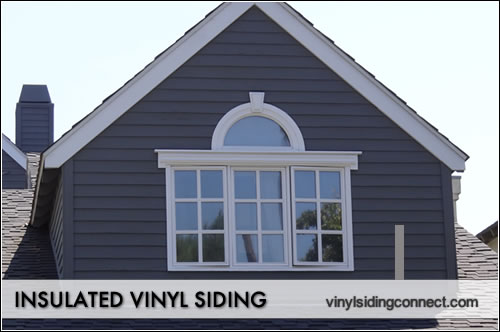Insulated vinyl siding differs from standard vinyl in the layer of dense foam applied to the back of each panel. This creates a more rigid panel that lays straighter and therfore looks truer. While the product cost is roughly 30% above standard vinyl, many homeowners think the additional money is worth the straighter and more energy efficient product.




Basics Of Insulated Vinyl Siding
Insulated vinyl siding has a foam layer (often made from polystyrene) that is essentially fused to the back of the panels. This can either be done during the initial manufacturing process or can be applied to traditional vinyl panels. The result is a more rigid panel that lays straighter and looks truer and more uniform. While many manufacturers claim performance ratings up to 5 times better than traditional options, many contractors and installers aren’t completely convinced that it makes a huge difference in terms of energy savings. The foam backing also helps to reduce noise levels, prevent dents and damage to the siding.

Insulated Vinyl Siding Cost
Low To Mid Range: $3.50 to $4.50 psf installed
Mid To Upper Range: $4.50 to $5.50 psf installed
IVS is more expensive than traditional options – vinyl that runs $1.40 per square foot might run $1.80 per square foot. The vinyl installation costs will be the same at roughly $1 to $2 psf.

Advantages Of Insulated Vinyl Siding

Straighter Walls
There is little doubt that the best aspect of IVS is the truer walls that it helps create and maintain. The rigidity of the foam backing does not allow for the subtle bend that can occur with the traditional material. The result is a straighter wall that maintains its shape for many years.

Less Dents Or Cracks
The foam acts to create straight walls, but also to provide stronger backing against dents, cracks and warping. This can make a huge difference in the look and condition of the cladding over time. This tends to be most needed for homeowners who live in stormy areas and those with younger kids (think baseballs and bikes).

Better Energy Efficiency
While many installers think the energy efficiency angle is played up by manufacturers, there are some benefits here. How much will the layer save in energy bills is a question of debate. IVS typically has an R value that is R-3 or higher.

Disadvantages

More Expensive
Certainly there are the costs to think about. If you are buying a siding that runs $1.40 per square foot for traditional, you would instead be paying more like $1.80 per square foot for insulated. This may not seem like much but it would mean an extra $800 for 20 squares of material. If you factor in the energy savings the difference over time goes down, although it’s hard to say by how much. More on vinyl siding cost.

Less Options & Colors
Because IVS is newer and less popular than traditional options, there will be less options and siding colors to choose from. However, many manufacturers may only have insulated product but it may be available in many of the standard color schemes.
Related Topics
Aluminum Options
Hardie Board Pricing
Fiber Cement Costs
Calculate Your Project Price



